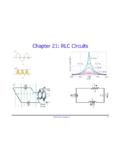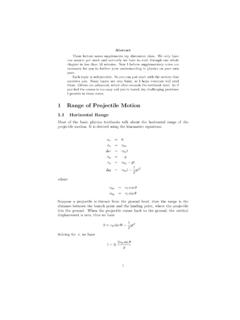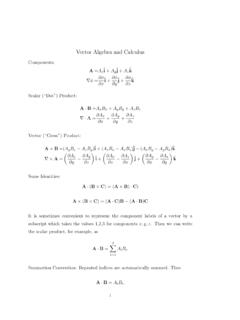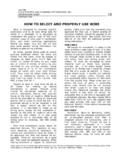Transcription of Exam 1 Solution - University of Florida
1 PHY2049 Summer 2012 Instructor: Francisco RojasExam 1 SolutionAs customary, choice (a) is the correct answer in all the following 1A uniformly charged (thin) non-conducting rod is located onthe central axis a distancebfrom the center of an uniformly charged non-conducting disk. The length of the rod isLand has a linear charge density . The disk has radiusaand a surface charge density .The total force among these two objects is(1)~F= 2 0(L+ a2+b2 (b+L)2+a2) k(2)~F= a2L4 0b2 k(3)~F= a2L8 0b2 k(4)~F= 2 0(1 L L2+a2) k(5)~F= L22 0 L2+a2 kSolutionWe saw in class that the electric field created at any point along the central axis is givenby~E(z) = 2 0(1 z a2+z2) kBreaking up the rod into an infinite number of infinitesimallysmall point chargesdq,we have that the net force on each tiny charge isd~F=dq~E(z).
2 Summing up all these1contributions, and using the fact thatdq= dzgives~F= dq 2 0(1 z a2+z2) k(1)= 2 0 k b+Lbdz(1 z a2+z2)(2)= 2 0 k(z a2+z2)b+Lb(3)= 2 0(L a2+ (b+L)2+ a2+b2) k(4)Problem 2A uniformly charged (thin) non-conducting shell (hollow sphere) of radiusRwith thetotal positive chargeQis placed at a distancedaway from an infinite non-conductingsheet carrying a uniformly distributed positive charge with a density . The distancedismeasured from shell s center (point O). What is the magnitude of the total electric fieldat the center of the shell?(1) 2 0(2)Q4 0R2+ 2 0(3)Q4 0R2+ 0(4)Q4 0R2(5)Q4 0R+ 0 SolutionThis is problem is very easy to solve if one recalls the superposition principle.
3 The totalelectric field at any point in space is equal to the sum of the individual contributions fromeach source. The electric field produced by the sphere in its interior is always zero1. Theelectric field produced by a non-conducting infinitely long sheet is 2 0everywhere in , the sum of these two contributions at the center of the sphere is simply 2 can be seen as a consequence of Gauss Law for this spherically symmetric situation2 Problem 3A round wastepaper basket with a m radius opening is in a uniform electric field of300 N/C, perpendicular to the opening. The total flux throughthe sides and bottom, inN m2/C, is:(1) - 21 (2) (3) 0 (4) 280 (5) can t tell without knowing theareas of the sides andbottomSolutionBecause the electric field is a constant everywhere, the electric flux through any closedsurface is zero.
4 Thus, we can write = ~E d~A= 0 Decomposing the entire surface of the basket into the sides,bottom, and top, yields = ~E d~A= sides~E d~A+ bottom~E d~A+ top~E d~A= 0thus sides~E d~A+ bottom~E d~A= top~E d~A(5)= E Atop(6)= E r2(7)= = 300 (8)= 21(9)Therefore sides~E d~A+ bottom~E d~A= 21N/Cm23 Problem 4An electric field given by~E= 10 i 5(y2+ 5) jpierces the Gaussian cube of the figure,where the cube is 2 m on a side. (E is in newtons per coulomb andyis in meters.) Whatis the net electric flux through the entire cube?(1) -80 N/C m2(2) 80 N/C m2(3) 0 (4) 20 N/C m2(5) -20 N/c m2 SolutionWe can break up the entire closed surface into the six sides ofthe cube.
5 The front andback sides do not contribute since~Elies on thex, yplane, thus it is parallel to these , thexcomponentEx= 10 of the electric field is constant. This implies that thecontributions from this component would cancel in each other out among all sides. Thesame will happen with the constant part inEy= 5y2 25. Therefore, we end up with = 5 y=2y2dxdz+ 5 y=0y2dxdz= 5 (2)2 A= 5 (2)2 22= 80 Problem 5A graph of thexcomponent of the electric field as a function ofxin a region of space isshown in the figure. The scale of the vertical axis is set byExs= N/C. Theyandzcomponents of the electric field are zero in this region. If the electric potential at theorigin is 10 V, what is the electric potential (in V) at x = m?
6 (1) 26 (2) -6 (3) 36 (4) 0 (5) 424 SolutionBy definition we haveVb Va= ba~E ~dsWhereaandbare just two points in which we measure the electric potentialV. Since weare given thatV(x= 0) = 10 V, we might as well use that as our pointa, andx= 4 asbto findVb. Since theyandzcomponents of the electric field are zero everywhere, we have~E ~ds=Exdx, andExis given by the plot as a function ofx. Therefore, we can writeVb=Va baExdx(10)But the integral above is simply the area under the We just need to becareful with the sign of that area since it is negative in the range 0 x 3, and positivein the rangex >4. Thus,V(x= 4) =V(x= 0) 40 Exdx(11)= 10 ( 24 + 8) = 26(12)Problem 6In the figure, a charged particle (either an electron or a proton; you need to find out whichit is) is moving rightward between two parallel charged plates.
7 The plate potentials areV1= 25 V andV2= 35 V. The particle is slowing down from an initial speed of 3 106m/s at the left plate. What is its speed, in m/s, just as it reaches plate 2?(1) 106(2) 106(3) not possible to know without knowing the plates separation(4) 1012(5) 1012 SolutionIf we use conservation of energy (potential plus kinetic), this problem is really straighfor-ward. The potential energy of the particle when it starts from plate 1 isU1=qV1and5when it arrives at plate 2 isU2=qV2. (Recall that the electric potential is a continuousfunction in space, therefore a particle very close to the plates will be at an electric potentialequal to the one on the plate2).
8 Therefore, conservation of energy readsU1+K1=U2+K2(13)qV1+12mv21=qV2+12mv2 2(14)Solving forv2givesv2= v21+2qm(V1 V2)(15)But now it comes a crucial point. Whatmdo we use? The mass of a proton or that of anelectron? This is very important since their masses differ bya factor of almost 2000! Toclarify this, we recall that~E= ~ V. This implies that the electric field, at a certain pointin space, points in theoppositedirection of~ Vat that location. Imagine we draw anxaxis going from plate 1 to plate 2. Since the electric field is constant everywhere betweenthe plates, ~E= (Ex,0,0) whereEx= constant, the potentialV(x) is a monotonicfunction ofxin going from one plate to the other.
9 Thus, since the potential at plate 1isV1= 25 V and decreases toV2= 35 V at plate 2,~ Vis negative along the entirerange ofx. In other words,~ Vpoints to negative direction ofx(left). Therefore, from~E= ~ Vwe arrive at the conclusion that~Epoints in the positive direction onx(right).Now, since the particle is slowing down, the total force on itmust be in the oppositedirection of motion. Since the particle is traveling to the right, the net force ought topoint to the left. From~F=q~E, we see that this is only possible ifqis negative since~Epoints to the right. Therefore, the particle is an then the electron s massme= 10 31kgs, and chargeq= 10 19C, we havev2= v21+2qm(V1 V2) = 106m/s(16)2 Notice that since~E= ~ V, the electric potentialVmust be a continuous function.
10 Otherwise itwould imply an infinite~ 7 The figure shows a parallel-plate capacitor of plate areaAand plate separation 2d. Theleft half of the gap is filled with material of dielectric constant 1= 12; the top of theright half is filled with material of dielectric constant 2= 20; the bottom of the right halfis filled with material of dielectric constant 3= 30. What is the capacitance in terms of 0,A, andd?(1) 9 0Ad(2) 62 0Ad(3) 18 0Ad(4) 31 0Ad(5) none of theseSolutionAssuming that the separation between the plates is much smaller than their extension,we can ignore fringe effects at the edges of the plates and at the junction of the twomaterials. Since the plates of a capacitor are made of conducting material, the plates areequipotential surfaces.



















